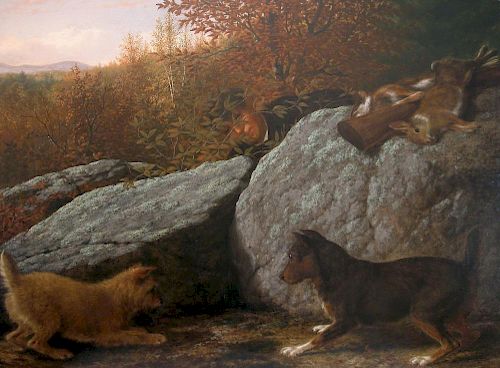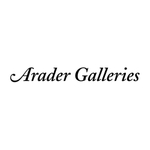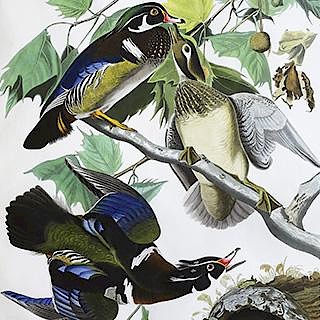Thomas H. Hinckley, Rabbit Hunting Oil Painting
Lot 95
About Seller
Arader Galleries
1308 Walnut Street
King of Prussia, PA 19406
United States
Arader Galleries proudly celebrates over 40 years in the business of important, antique works on paper, paintings and rare books. W. Graham Arader III began his collection of rare maps, atlases and Americana while an undergraduate at Yale University, and today that passion has grown into one of the ...Read more
Categories
Estimate:
$20,000 - $30,000
Absentee vs Live bid
Two ways to bid:
- Leave a max absentee bid and the platform will bid on your behalf up to your maximum bid during the live auction.
- Bid live during the auction and your bids will be submitted real-time to the auctioneer.
Bid Increments
| Price | Bid Increment |
|---|---|
| $0 | $25 |
| $500 | $50 |
| $1,000 | $100 |
| $2,000 | $250 |
| $5,000 | $500 |
| $10,000 | $1,000 |
| $20,000 | $2,000 |
| $50,000 | $5,000 |
| $100,000 | $10,000 |
| $200,000 | $25,000 |
About Auction
By Arader Galleries
Jan 28, 2017 - Jan 29, 2017
Set Reminder
2017-01-28 13:00:00
2017-01-29 13:00:00
America/New_York
Bidsquare
Bidsquare : Arader Galleries Winter 2017 Auction
https://www.bidsquare.com/auctions/arader/arader-galleries-winter-2017-auction-2063
Arader Galleries loricohen@aradergalleries.com
Arader Galleries loricohen@aradergalleries.com
- Lot Description
Rabbit Hunting. Thomas Hewes Hinckley (1813-1896). Oil on canvas, 1868. Signed and dated lower right: "T.H. Hinckley / 1868". 35 3/4 x 48 inches. Provenance: Ferargil Galleries, New York, 1945; Edward Eberstadt & Sons, New York, 1958; Kennedy Galleries, New York; private collection, until 2007 Exhibited: Ferargil Galleries, New York, Nineteenth Annual Early American Paintings, October 1945, no. 14 (as Hunters). Literature: 1908-1958: Our Golden Anniversary Catalogue of American Paintings (New York: Edward Eberstadt & Sons, 1958), no. 87 (as Flushing Wild Game). Related works: The Rabbit Hunters, 1850, oil on canvas, 40 x 54 ¼ inches (The Metropolitan Museum of Art, New York); Hunting Scene in Milton, Massachusetts, 1868, oil on canvas, 14 x 21 inches (Godel & Co.). Thomas Hewes Hinckley was born in Milton, Massachusetts, where he showed an early talent for drawing. While apprenticed to a merchant in Philadelphia, Hinckley attended evening drawing classes taught by William Mason. Hinckley first worked as a sign painter in 1833 before turning to portraiture and eventually to animal painting. He built a studio in Milton and in 1845 was commissioned by Daniel Webster to draw Webster’s famous Ayrshire cattle herd. The American Art-Union purchased many paintings that resulted from these sketches, and in 1846 the National Academy of Design also exhibited two cattle paintings. Under the sponsorship of William W. Swain, Hinckley sketched deer at Naushon Island, off the coast of Massachusetts, and later continued these studies in the Adirondacks. In 1851 he visited Europe, where he studied the works of Edwin Henry Landseer among other English and Flemish painters, and in 1858 he exhibited two paintings of dogs with game at the Royal Academy in London. Later, he spent time making studies of elk in California, but ultimately returned to Milton to continue his studies of animals and the Massachusetts landscape. In the late 1860s, Hinckley revisited the hunting subjects he had painted before his European tour with fresh eyes. In our Rabbit Hunting, he refined the composition of his 1851-52 submission to the American Art-Union, The Rabbit Hunters, 1850 (The Metropolitan Museum of Art, New York). In the 1850 painting, the rabbit chase was only one element in a composition that also included landscape vistas and a scene of a hunter playing with his dog, but in the 1868 painting, Hinckley minimized the other elements and unified the action around the crevice through which a rabbit has slipped. Having seen Landseer’s work in England, Hinckley also posed the animals with greater naturalism, and he enlivened the picture with a more colorful palette. Thomas Hewes Hinckley’s paintings and drawings were exhibited at the American Art-Union, National Academy of Design, Pennsylvania Academy of the Fine Arts, Brooklyn Art Association, Boston Athenaeum, Boston Art Club, and the Royal Academy, London. His work can be found in the collections of The Metropolitan Museum of Art, New York; Museum of Fine Arts, Boston; Milton Public Library, Massachusetts; Corcoran Gallery of Art, Washington, D. C.; and the Shelburne Museum, Vermont.
- Shipping Info
-
Shipping Terms:Packing and handling of purchased lots by us or by someone else is at the entire risk of the purchaser. Purchasers are responsible for all packing and shipping costs.
We are not responsible for the acts or omissions of carriers or packers of purchased lots whether or not recommended by us.
-
- Buyer's Premium



 EUR
EUR CAD
CAD AUD
AUD GBP
GBP MXN
MXN HKD
HKD CNY
CNY MYR
MYR SEK
SEK SGD
SGD CHF
CHF THB
THB



